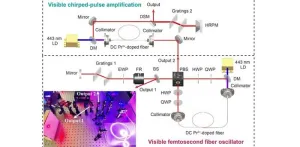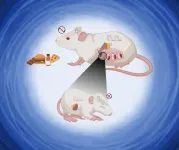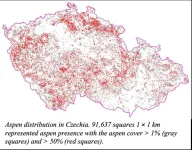(Press-News.org) The emergence of ultrafast laser pulse generation, marking a significant milestone in laser science, has triggered incredible progress across a wide array of disciplines, encompassing industrial applications, energy technologies, life sciences, and beyond. Among the various laser platforms that have been developed, fiber femtosecond oscillators, esteemed for their compact design, outstanding performance, and cost-effectiveness, have become one of the mainstream technologies for femtosecond pulse generation. However, their operating wavelengths are predominantly limited to the infrared region, spanning from of 0.9-3.5 μm, which has, in turn, restricted their applicability in numerous applications that require light sources at visible wavelengths (390-780 nm). Expanding compact femtosecond fiber oscillators into new visible wavelengths has long been a challenging yet fervently pursued goal in laser science.
Currently, the majority of visible fiber lasers use rare-earth-doped fluoride fibers, such as Pr3+, as the effective gain medium. Over the years, remarkable advancements have been made in developing wavelength-tunable, high-power, Q-switched, and mode-locked visible fiber lasers. However, despite the significant progress in the near-infrared region, achieving femtosecond mode-locking in visible fiber lasers remains an exceptionally challenging task. This challenge is attributed to the underdevelopment of ultrafast optics components at visible wavelengths, limited availability of high-performance visible modulators, and the extremely normal dispersion encountered in visible fiber laser cavities.
Recent attention has focused on femtosecond mode-locked fiber oscillators in near-infrared using a phase-biased nonlinear amplifying loop mirror (PB-NALM). PB-NALM eliminates the need for long intracavity fibers to accumulate phase shifts. This innovation not only facilitates tuning flexibility and long-life operation but also provides an opportunity to manage the intracavity dispersion in a larger parameter space from normal to anomalous dispersion regimes. Consequently, it is anticipated to catalyze a breakthrough in direct femtosecond mode-locking of visible fiber laser and propel fiber femtosecond oscillators into the visible band.
Researchers from the Fujian Key Laboratory of Ultrafast Laser Technology and Applications at Xiamen University recently developed a visible-light mode-locked femtosecond fiber oscillator and amplifier, as reported in Advanced Photonics Nexus. The fiber femtosecond oscillator, which emits red light at 635 nm, employs a figure-nine cavity configuration. It applies a double-clad Pr3+-doped fluoride fiber as the visible gain medium, incorporates a visible-wavelength PB-NALM for mode-locking, and utilizes a pair of customized high-efficiency and high-groove-density diffraction gratings for dispersion management. A visible self-starting mode-locking established by the PB-NALM directly yields red laser pulses with a pulse duration of 199 fs and a repetition rate of 53.957 MHz from the oscillator. Precise control of the grating pair spacing can switch the pulse state from a dissipative or stretched-pulse soliton to a conventional soliton. Additionally, a chirped-pulse amplification system built alongside the oscillator boosts the laser performance immensely, resulting in an average output power over 1 W, a pulse energy of 19.55 nJ, and a dechirped pulse duration of 230 fs.
Prof. Zhengqian Luo, head of the Electronic Engineering Department of Xiamen University, remarks, “Our result represents a concrete step toward high-power femtosecond fiber lasers covering the visible spectral region and could have important applications in industrial processing, biomedicine, and scientific research.”
The authors anticipate that their new scheme for high-performance visible-light femtosecond fiber laser generation will lay the foundations for visible-light femtosecond fiber lasers to serve in applications such as special material precision processing, biomedicine, underwater detection, and optical atomic clocks.
See the original Gold Open Access article by J. Zou, Q. Ruan, et al., “635 nm femtosecond fiber laser oscillator and amplifier,” Adv. Photon. Nexus 3(2) 026004 (2024), doi 10.1117/1.APN.3.2.026004
END
Unlocking visible femtosecond fiber oscillators: A breakthrough in laser science
Researchers advance visible-wavelength fiber lasers to propel laser technology forward
2024-03-27
ELSE PRESS RELEASES FROM THIS DATE:
Long-period oscillations control the Sun’s differential rotation
2024-03-27
The Sun’s differential rotation pattern has puzzled scientists for decades: while the poles rotate with a period of approximately 34 days, mid-latitudes rotate faster and the equatorial region requires only approximately 24 days for a full rotation. In addition, in past years advances in helioseismology, i.e. probing the solar interior with the help of solar acoustic waves, have established that this rotational profile is nearly constant throughout the entire convection zone. This layer of the Sun stretches ...
A combination of approved drugs enhances the delivery of anti-bacterial medications to treat tuberculosis
2024-03-27
BOSTON – Tuberculosis (TB) is often overlooked in developed countries such as the United States, but this bacterial infection remains one of the deadliest diseases globally and results in millions of deaths annually.
Deaths can occur even with treatment, sometimes because of drug resistance in TB bacteria and other times due to poor delivery of TB-targeting drugs to patients’ infected lung tissue.
To address the latter challenge, a team led by researchers at Massachusetts General Hospital (MGH) in collaboration with scientists at the National Institute of Allergy and ...
Could AI play a role in locating damage to the brain after stroke?
2024-03-27
EMBARGOED FOR RELEASE UNTIL 4 P.M. ET, WEDNESDAY, MARCH 27, 2024
MINNEAPOLIS – Artificial intelligence (AI) may serve as a future tool for neurologists to help locate where in the brain a stroke occurred. In a new study, AI processed text from health histories and neurologic examinations to locate lesions in the brain. The study, which looked specifically at the large language model called generative pre-trained transformer 4 (GPT-4), is published in the March 27, 2024, online issue of Neurology® Clinical Practice, an official journal of the American Academy of Neurology.
A stroke can ...
High fat/low protein diets in rats during pregnancy and postnatally may cause altered glucose control and other "maladaptive" metabolic changes in their offspring
2024-03-27
High fat/low protein diets in rats during pregnancy and postnatally may cause altered glucose control and other "maladaptive" metabolic changes in their offspring
###
Article URL: https://journals.plos.org/plosone/article?id=10.1371/journal.pone.0299554
Article Title: Intrauterine and early-life malnutrition in rats disrupts the circadian rhythm programming of energy metabolites through adulthood
Author Countries: México
Funding: This research was partially supported by PD-LBAE-FC UNAM 2015-2019, DGAPA ...
Just 1 in 14 adults across 55 LMICs who have both hypertension and diabetes have both conditions under adequate control
2024-03-27
Just 1 in 14 adults across 55 LMICs who have both hypertension and diabetes have both conditions under adequate control, with only 20-30% of patients taking medications, indicating a lack of adequate healthcare in these settings.
======
Article URL: https://journals.plos.org/globalpublichealth/article?id=10.1371/journal.pgph.0003019
Article Title: Multiple cardiovascular risk factor care in 55 low- and middle-income countries: A cross-sectional analysis of nationally-representative, individual-level data from 280,783 adults
Author Countries: ...
Your emotional reaction to climate change may impact the policies you support
2024-03-27
Emotional reactions to climate change may lead to specific policy preferences, according to a study published March 27, 2024 in the open-access journal PLOS Climate by Teresa A. Myers of George Mason University and colleagues.
A politician, public speaker, or journalist may opt for an emotional appeal when communicating about climate change. Indeed, research shows that emotional investment can raise awareness of important issues and galvanize an otherwise apathetic public. However, existing research has not explored the unique links between specific ...
Persistent hiccups in a far-off galaxy draw astronomers to new black hole behavior
2024-03-27
At the heart of a far-off galaxy, a supermassive black hole appears to have had a case of the hiccups.
Astronomers from MIT, Italy, the Czech Republic, and elsewhere have found that a previously quiet black hole, which sits at the center of a galaxy about 800 million light years away, has suddenly erupted, giving off plumes of gas every 8.5 days before settling back to its normal, quiet state.
The periodic hiccups are a new behavior that has not been observed in black ...
Europe’s forgotten forests could be 21st century ‘biodiversity hot spots’
2024-03-27
An overlooked and long-neglected type of forest has vast capacity to rebound, enhancing species diversity and resilience to climate change, according to an international team of forest scientists.
According to new research, published today in the peer-reviewed science journal PLOS ONE, there is ample habitat for the Eurasian aspen, and these environments will continue to be suitable for this “keystone species” as the global climate warms.
“The Eurasian aspen, and aspen species globally, are home to vast populations of other dependent plants and animals,” said the study’s lead author, Antonin Kusbach, an applied ecologist at Mendel University in ...
Combining epigenetic cancer medications may have benefit for colorectal cancers and other tumor types
2024-03-27
GRAND RAPIDS, Mich. (March 27, 2024) — A pair of medications that make malignant cells act as if they have a virus could hold new promise for treating colorectal cancers and other solid tumors, reports a study published today in Science Advances.
The preclinical research, led by Van Andel Institute scientists, determined how low doses of a DNMT inhibitor sensitize cancer cells to an EZH2 inhibitor, resulting in a one-two punch that combats cancer cells better than either drug alone.
The findings are the foundation for an upcoming Phase I clinical trial to evaluate this combination ...
Reevaluating an approach to functional brain imaging
2024-03-27
A new way of imaging the brain with magnetic resonance imaging (MRI) does not directly detect neural activity as originally reported, according to scientists at MIT’s McGovern Institute. The method, first described in 2022, generated excitement within the neuroscience community as a potentially transformative approach. But a study from the lab of McGovern associate investigator Alan Jasanoff, reported March 27, 2024, in the journal Science Advances, demonstrates that MRI signals produced by the new method are generated in large part by the imaging process itself, ...
LAST 30 PRESS RELEASES:
Numbers in our sights affect how we perceive space
SIMJ announces global collaborative book project in commemoration of its 75th anniversary
Air pollution exposure and birth weight
Obstructive sleep apnea risk and mental health conditions among older adults
How talking slows eye movements behind the wheel
The Ceramic Society of Japan’s Oxoate Ceramics Research Association launches new international book project
Heart-brain connection: international study reveals the role of the vagus nerve in keeping the heart young
Researchers identify Rb1 as a predictive biomarker for a new therapeutic strategy in some breast cancers
Survey reveals ethical gaps slowing AI adoption in pediatric surgery
Stimulant ADHD medications work differently than thought
AI overestimates how smart people are, according to HSE economists
HSE researchers create genome-wide map of quadruplexes
Scientists boost cell "powerhouses" to burn more calories
Automatic label checking: The missing step in making reliable medical AI
Low daily alcohol intake linked to 50% heightened mouth cancer risk in India
American Meteorological Society announces Rick Spinrad as 2026 President-Elect
Biomass-based carbon capture spotlighted in newly released global climate webinar recording
Illuminating invisible nano pollutants: advanced bioimaging tracks the full journey of emerging nanoscale contaminants in living systems
How does age affect recovery from spinal cord injury?
Novel AI tool offers prognosis for patients with head and neck cancer
Fathers’ microplastic exposure tied to their children’s metabolic problems
Research validates laboratory model for studying high-grade serous ovarian cancer
SIR 2026 delivers transformative breakthroughs in minimally invasive medicine to improve patient care
Stem Cell Reports most downloaded papers of 2025 highlight the breadth and impact of stem cell research
Oxford-led study estimates NHS spends around 3% of its primary and secondary care budget on the health impacts of heat and cold in England
A researcher’s long quest leads to a smart composite breakthrough
Urban wild bees act as “microbial sensors” of city health.
New study finds where you live affects recovery after a hip fracture
Forecasting the impact of fully automated vehicle adoption on US road traffic injuries
Alcohol-related hospitalizations from 2016 to 2022
[Press-News.org] Unlocking visible femtosecond fiber oscillators: A breakthrough in laser scienceResearchers advance visible-wavelength fiber lasers to propel laser technology forward





